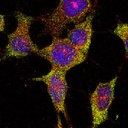In planta sequential hydroxylation and glycosylation of a fungal phytotoxin: Avoiding cell death and overcoming the fungal invader.
Kľúčové slová
Abstrakt
To facilitate plant colonization, some pathogenic fungi produce phytotoxic metabolites that damage tissues; plants may be resistant to a particular pathogen if they produce an enzyme(s) that catalyzes detoxification of this metabolite(s). Alternaria blackspot is one of the most damaging and significant fungal diseases of brassica crops, with no source of resistance known within the Brassica species. Destruxin B is the major phytotoxin produced by the blackspot-causing fungus, Alternaria brassicae (Berkley) Saccardo. We have established that a blackspot-resistant species (Sinapis alba) metabolized (14)C-labeled destruxin B to a less toxic product substantially faster than any of the susceptible species. The first metabolite, hydroxydestruxin B ((14)C-labeled), was further biotransformed to the beta-d-glucosyl derivative at a slower rate. The structures of hydroxydestruxin B and beta-d-glucosyl hydroxydestruxin B were deduced from their spectroscopic data [NMR, high resolution (HR)-MS, Fourier transform infrared (FTIR)] and confirmed by total chemical synthesis. Although these hydroxylation and glucosylation reactions occurred in both resistant (S. alba) and susceptible (Brassica napus, Brassica juncea, and Brassica rapa) species, hydroxylation was the rate limiting step in the susceptible species, whereas glucosylation was the rate limiting step in the resistant species. Remarkably, it was observed that the hydroxydestruxin B induced the biosynthesis of phytoalexins in blackspot-resistant species but not in susceptible species. This appears to be a unique example of phytotoxin detoxification and simultaneous phytoalexin elicitation by the detoxification product. Our studies suggest that S. alba can overcome the fungal invader through detoxification of destruxin B coupled with production of phytoalexins.


